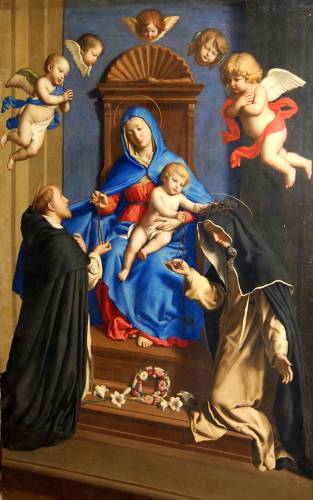Before we reflect on Eucharistic devotion, let us reflect for a moment on what it is we as Catholics believe about the Eucharist. Put simply, we believe that it is the source and summit of the Christian life. In it we have present the very reality of Jesus, the Christ, in his flesh and blood. God, who wishes us to companion us, and to be with us as friend, (1) is present to us under the forms of bread and wine. The creator of the universe, God who is, in whom all time and history find their meaning, desires to be with us, in this time and place. He seeks to enter our life and our world.
For us who are devoted to the Precious Blood, Eucharistic devotion should be a specific and generous feature of our life and prayer. "The spirituality of Saint Gaspar ... is truly at the heart of the Christian life: the Most Precious Blood of our Lord has always been the object of a special attention on the part of all the saints: it is the school of sanctity, of justice, of love... Never cease...to delve deeply into this mystery of justice and love: diffuse it into the whole world." (2) Adoration was to be a regular feature of the missionary's life according to instructions left by St. Gaspar.(3)
If all this is true, if we indeed believe that this is true, that God is truly present to us, for us to see and to taste, what is it that prevents us from spending hours with this divine guest? To be in relationship with someone, one needs to spend time in their presence, to listen to them speak and to engage them in conversation. If one is to be intimate with another, meals and times for sharing are the center of this experience. This is precisely what the Lord wishes for us and from us. He desires that we respond to his invitations to friendship and intimacy.
The perfect means to enter into the grace of this relationship is Eucharistic Devotion, Adoration of the Blessed Sacrament. Flowing from the Celebration of the Eucharist, this gives us an opportunity to relish the words that we shared there and to cherish the presence of one who loves us beyond our imagination. (4) The liturgical reforms of Vatican II were meant to restore a balance in Celebration of the Eucharist and Eucharistic Adoration. The Celebration of the Eucharist leads us to Adoration, and Adoration prepares our hearts and leads us to a fuller celebration of the Eucharist.
Here at St. Edward Catholic Church there is Eucharistic Adoration every morning at 5:30am, and every afternoon at 4:15pm. Eucharistic Adoration is from the 9:00am Mass to 5:30pm every first Friday. Once a year we have an over-night period of adoration in reparation for the abuse of the dignity of life. Eucharistic adoration can take place at other times during the day even though the Blessed Sacrament is reserved in the tabernacle. When the Blessed Sacrament is exposed we are more attentive, but when he is reserved in the tabernacle, the door does not impede his presence or attention to your heart.
Times of silence in the presence of the Blessed Sacrament are a rich opportunity for God's people. We are bombarded each day with a variety of media, radio and television and newspaper. We listen to all sorts of voices from idle conversation, to news and opinion from the world and the neighborhood. Silence in the presence of the living Word of God helps us to recognize the one voice calling to us above all the others to the fullness of life. We are his people and how we respond to his voice indicates how we belong to his flock, to his people. "My sheep hear my voice; I know them, and they follow me." (5)
Occasionally people would be anxious if Sunday liturgy is more than an hour. If we truly believed what we do as Catholics, we would have a desire to spend at least an hour each day in the presence of the one who loves us. Indeed God is present to us in many ways; in his people and in his word, yet here we have the true presence of God par excellence.
NOTES
(1) I no longer call you servants, but friends. (John 15:15)
(2) John Paul II to the Missionaries of the Precious Blood, 1986, and repeated in 1989
(3) Letter from St. Gaspar, March 1831, to Pope Gregory XVI: "The sacred functions of each day have been described above. The weekly functions are the following: On Thursdays, the adoration of the most Blessed Sacrament in memory of the institution of that divine mystery. Each Missionary, in turn, is asked to direct this tender exercise"
(4) See also the 1967 Instruction on the Worship of the Eucharistic Mystery, "Eucharisticum Mysterium," 50. "When the faithful adore Christ present in the sacrament, they should
remember that this presence derives from the sacrifice and has as its
purpose both sacramental and spiritual communion."
(5) John 10:27


